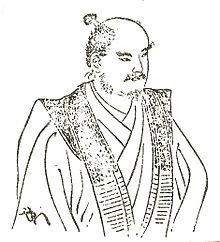Shima Sakon
This article does not cite any sources. (July 2007) |
Shima Sakon 島 左近 | |
|---|---|
 Shima Sakon | |
| Other name(s) | Shima Kiyooki, Shima Tomoyuki, Shima Katsutake |
| Born | June 9, 1540 Yamato province, Japan |
| Allegiance | |
| Commands held | Tsutsui Junkei Toyotomi Hideyoshi Ishida Mitsunari |
| Battles/wars | Siege of Hijiyama Battle of Yamazaki Battle of Komaki-Nagakute Kyushu Campaign Battle of Kuisegawa Battle of Sekigahara |
| Relations | Shima Matsukatsu (father) |
Shima Kiyooki (島 清興, 9 June 1540 - ?), also known as Shima Sakon (島 左近), Shima Tomoyuki and Shima Katsutake, was a Japanese samurai of the late Sengoku period. Sakon eventually left the service of the Tsutsui, Toyotomi and eventually joined and serve under Ishida Mitsunari.
Biography[]
He was born in the Yamato province to Shima Matsukatsu, Sakon began his career as a samurai retainer under the Hatakeyama clan. Sakon eventually became one of the two primary officers under Tsutsui Junkei alongside .
In 1586, after the death of Junkei, Sakon was convinced to serve the Toyotomi under Toyotomi Hidenaga (Hideyoshi’s brother) at Kyushu Campaign.
In 1598, after Hideyoshi's died, Ishida Mitsunari recruited him into his army as a leading strategist. Sakon proceeded to help Mitsunari as he struggled against Tokugawa Ieyasu.

Battle of Sekigahara[]
In 1600, a few days before the battle of Sekigahara, Sakon led an assault on Ieyasu’s Eastern army at Kuisegawa with great success. Later at the Battle of Sekigahara, Shima served as one of Ishida's higher-ranking officers, commanding a unit of 1,000 men. Some sources suggest Shima led musketmen and that his position had cannons. He fought against Hosokawa Tadaoki and was shot by riflemen led by Kuroda Kanbei's son Nagamasa, forcing him to retreat. His fourth son, Shima Kiyomasa within Yoshitsugu's ranks, killed by an 'Eastern' samurai named Takagi Heizaburō. His fate remains somewhat of a mystery since he or his body was not on the battlefield after the battle. Some say he died of his wounds after the battle or escaped and died a few years later.
See also[]
- People of the Sengoku period in popular culture
External links[]
- 1540 births
- 1600 deaths
- Samurai
- Japanese warriors killed in battle
- Samurai stubs